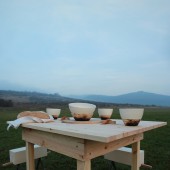KALÁKA Furniture collection- Table by Hidegszoba studio |
Home > Winners > #39106 |
 |
|
||||
| DESIGN DETAILS | |||||
| DESIGN NAME: KALÁKA PRIMARY FUNCTION: Furniture collection- Table INSPIRATION: These design objects are a result of a university seminar on design, but were born as an individual collection under the topic of Future tradition / Ornament and Structure. Similar to the elements of folktales, our objects are accustomed household pieces, which bare an The central symbol of grain-based dietary is bread; expressing the respect towards bread, we have placed it in the centre of the table. Accompanying it, we made an experimental series of plates with a charred base, reminiscent of open-air grilling and cooking on fire. UNIQUE PROPERTIES / PROJECT DESCRIPTION: Throughout the designing process, we have studied the definitive, visual and abstract meanings of ornament in order to understand its potential interpretations and transliterations to the Hungarian and other cultures. We have found the most natural bond in the language and in its recurring patterns. Our approach was to find certain manifestations of the language, which are possible to be visualised or objectified. We have found this possibility in the trio of tales, superstitions and sayings. OPERATION / FLOW / INTERACTION: The oak tree puck in the middle of the table can be used as a cutting board. In the center of the table there is a hole and a big basket in which you can store food or other things. PROJECT DURATION AND LOCATION: The project started in Decembre 2014 in Hungary (Budapest) and finished in January 2015. FITS BEST INTO CATEGORY: Furniture Design |
PRODUCTION / REALIZATION TECHNOLOGY: The design of the table was made by traditional woodworking techniques. SPECIFICATIONS / TECHNICAL PROPERTIES: 1100mm x 800mm x 750mm TAGS: furniture, wood, table, tales, folk RESEARCH ABSTRACT: Throughout the designing process, we have studied the definitive, visual and abstract meanings of ornament in order to understand its potential interpretations and transliterations to the Hungarian and other cultures. Due to our doubts concerning the precarious and uncertain roots of visual shapes, we have found the most natural bond in the language and in its recurring patterns. Our approach was to find certain manifestations of the language, which are possible to be visualised or objectified. We have found this possibility in the trio of tales, superstitions and sayings. Similar to the elements of folktales, our objects are accustomed household pieces, which bare an extra, special skill. The central symbol of grain-based dietary is bread; expressing the respect towards bread, we have placed it in the centre of the table. Accompanying it, we made an experimental series of plates with a charred base, reminiscent of open-air grilling and cooking on fire.The tipping intersection of the mobile shelf along the brushy top of the upper part leaves a range of possibilities to the user as much as it is to inspire consideration and conscious utilization. The materials combined in the animorph seats with a two-stick end allowed us to experiment and also to put an emphasis on the alternations of cross-sections. CHALLENGE: Designing objects and learn through handicraft was our main interest during the project. Learning by doing, We tend to get to know different materials and use them as they are. In furniture design the objects are in direct contact with people therefore it is important to keep them pure and simple, yet interesting enough to encourage their users to think about their surroundings and habits. ADDED DATE: 2015-02-18 18:46:15 TEAM MEMBERS (3) : Designer: Adrienn Tillinger, Designer: Aliz Török and Designer: Nelli Szabó IMAGE CREDITS: Image #1-5: Photographer Aliz Török, KALÁKA, 2014. |
||||
| Visit the following page to learn more: https://www.behance.net/gallery/22065361 |
|||||
| AWARD DETAILS | |
 |
KalÁka Furniture Collection-Table by Hidegszoba Studio is Winner in Furniture Design Category, 2014 - 2015.· Press Members: Login or Register to request an exclusive interview with Hidegszoba studio. · Click here to register inorder to view the profile and other works by Hidegszoba studio. |
| SOCIAL |
| + Add to Likes / Favorites | Send to My Email | Comment | Testimonials | View Press-Release | Press Kit |







